The California kingsnake is one of the most popular pet snakes.
It is not difficult to understand why the California kingsnake (Lampropeltis getula californiae), a subspecies of the common kingsnake, is so popular. Adults reach up to only 4 feet in length. They adapt well to captivity, possess a calm temperament and display a large variety of patterns for hobbyists to enjoy. They also reproduce readily, which has helped make them affordable to most reptile enthusiasts. Cared for properly, they can live between 10 and 15 years.
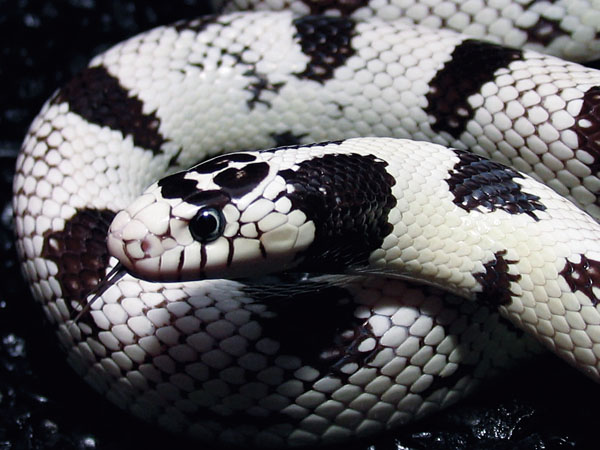
Photo by Maria Heidkamp Scully
This pattern phase is a derivative of the 50/50 desert-banded pattern where the percentage of white has expanded to about 70 percent along the body of the snake. The remaining dark pattern forms incomplete bands of black splotches or spots.
California Kingsnake Natural Kingdom
California kingsnakes’ natural range is limited to the western United States. Found throughout California, they also occur in southwestern Oregon, southern Nevada and Utah, and most of Arizona. They can often be found underneath leaf litter, man-made structures and other debris.
These diurnal constrictors are aggressive and skilled hunters. Their diet includes rodents, lizards, birds and bird eggs. Kingsnakes are also ophiophagous; they can and will eat other snakes. In fact, this nonvenomous snake can even kill and devour highly venomous snakes.
In the wild, California kingsnakes are normally either banded or striped, and their colors range between black and brown with white or yellow markings. In banded animals the light color forms rings around the circumference of the snake’s body. Bands are usually wider approaching the snake’s belly. Striped animals display a light-colored stripe on the dorsal surface running longitudinally. Albino and lavender morphs have also been found to occur naturally in certain regions.
Check out the video showing a California kingsnake attacking and consuming a rattlesnake.
Choosing A California Kingsnake
California kingsnakes can be purchased online, from a specialized breeder or from your local pet store. Before you bring one home, research its needs and ask the seller how the snake you’re interested in is feeding. Select one that has eaten thawed mice consistently.
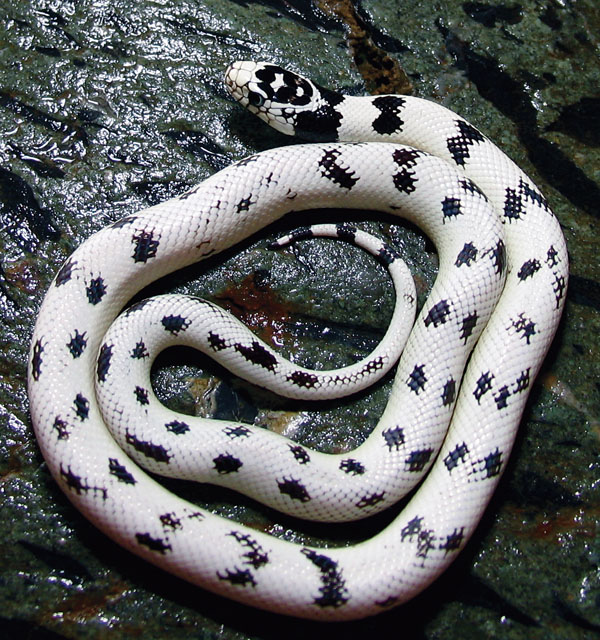
Photo by Maria Heidkamp Scully
Although this kingsnake may appear to be a high-white phase, its 50/50 banded tail pattern, which differs from the striped tail of high-whites, helps give away its genetics. Both parents were desert-banded animals 70 percent white and 30 percent black. This reverse double-dotted pattern is a rare occurence.
Make sure the snake is well-hydrated. Wrinkled or baggy skin indicates dehydration in many cases. Most sources offer some type of health guarantee, so be sure to inquire about policies should the animal get sick or die within a certain period of time.
Also find out whether the snake is captive-produced. Because captive-bred California kingsnakes are so abundant these days, there is no reason to obtain a wild-caught one, which might carry parasites, have other health issues or may refuse to feed on thawed rodents. Save yourself future headaches; purchase captive-bred animals.
If you are considering a California kingsnake as a first snake for a youngster, supervise all care and handling of the snake.
Handling A California Kingsnake
Always give a new captive a couple days to adjust to its new enclosure without attempting to feed or handle it. Hatchlings are often nervous as they learn to interpret and respond to their new owner and environment.
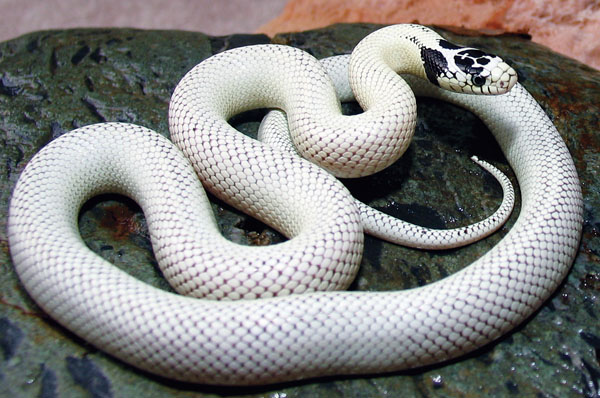
Photo by Maria Heidkamp Scully
This juvenile creamy-white of the high-white phase exhibits a highly desirable pattern for captive breeders: 100 percent white along its body length. This animal also lacks the characteristic black dorsal stripe along the length of its tail.
Their defensive display is easy to spot. They often rear up into an S, shake their tails and can strike out into the air. If a stray finger gets in their way, they may leave two pinpricks. A bite is a little more painful than a mosquito bite, yet the initial response is to drop the young snake. Avoid this to prevent injury to it, and it’s best to continue gently holding the snake. The hatchling must learn that you are not a threat and biting you will not make you go away. If its flee response continues for too long, however, return the snake to its enclosure to avoid stressing it with too much activity too soon.
Other defensive tactics in young California kingsnakes are to emit a musky smell and/or to defecate on you. Although not particularly pleasant, these are harmless maneuvers, and they lessen with regular, gentle handling sessions.
When you pick up the snake, allow it to move freely through your fingers while supporting it with both hands. Do not grab or restrain your snake. If you do, it may interpret that as a threat and become aggressive and stressed. Once feeding begins, avoid handling your snake after it eats for at least two days. Handling too soon can sometimes cause regurgitation.
California Kingsnake Enclosure
As hatchlings, California kingsnakes are approximately 8 to 10 inches long. A 10-gallon tank with an escapeproof lid is sufficient for a young snake. Screen tops that slide and lock in place work well.
Due to their voracious appetite, they can grow rather quickly, and they usually achieve adulthood in about three years. A 4-foot-long adult should be comfortable in an enclosure approximately 3 feet long by 11⁄2 feet wide by 1 foot tall. The habitat’s length and width are more important than its height.
Although California kingsnakes aren’t the best climbers, don’t be surprised if you find your snake wedged along the enclosure’s top lip. Their curiosity drives them to investigate every inch of their habitat. The smallest lid opening can provide them with the opportunity to pull a Houdini act, so check carefully for possible tank escape routes.
Ideal Kingsnake Enclosure
Providing the proper thermal gradient for your California kingsnake is essential to its health and general well-being. The proper gradient is 85 to 90 degrees Fahrenheit at the cage’s warm end and 70 to 75 degrees at the cool end.
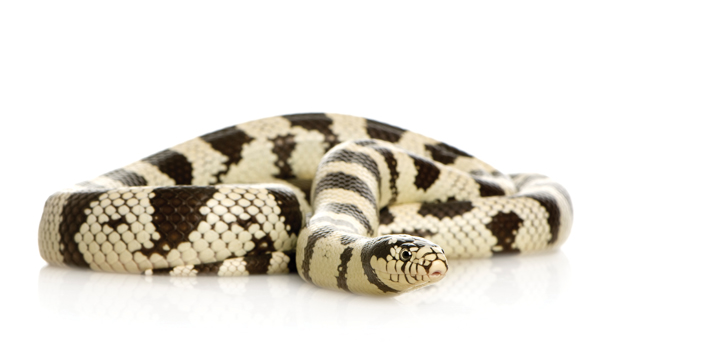
Photo by Maria Heidkamp Scully
Adlut California kingsnakes may grow up to 4 feet.
I prefer undertank heat sources over the use of heat rocks or heat lamps, so place an undertank heating pad at what will be the warm end. It should cover approximately one-third of the enclosure lengthwise. I place 1 to 2 inches of substrate in the tank’s warm area to prevent it from getting too hot.
Another way to monitor heat is to use a thermostat and probe in combination with a heating element. This provides a constant thermal gradient even if the room temperature changes, as it often does throughout the day and during different seasons.
A number of suitable substrates are appropriate for a kingsnake enclosure, including aspen shavings, Carefresh bedding or bark chips. Minimalist snakekeepers can use newspaper or paper towel layers. Avoid cedar shavings because oils in them are toxic to reptiles. It is also important to keep the substrate clean and dry at all times. If aspen shavings or similar particulate materials are used, do not put food items directly on the substrate. A slightly wet, thawed mouse can get substrate stuck to it, and the snake might accidentally ingest it. This may lead to impaction, which can have deadly consequences for the snake.
Provide clean drinking water at all times. A sturdy water dish large enough for the snake to soak is ideal. Check the dish, and clean it frequently because these snakes often defecate in their water source. This often occurs just after you do a water change!
Humidity should be kept relatively low, so place the water dish in an intermediate position in the tank. In the winter months of northern climates, when air humidity is particularly low, a room humidifier can help maintain sufficient air moisture. If a complete shed is not obtained, this can mean that the humidity is too low. Provide increased local humidity with a lidded plastic container. Find one of sufficient size for the snake to curl up comfortably. Make an access hole on top large enough for the snake to enter. Fill the container with damp sphagnum moss or moist paper towels. This setup allows the animal to get the moisture it needs in order to shed properly.
Hiding areas such as hide boxes provide your snake with a sense of security and reduce possible stress. These boxes should be large enough to accommodate the snake when it’s curled up. Increase the size of hide boxes as the snake grows. Provide a hiding place at both the warm and cool ends of its enclosure.
Feeding Kingsnakes
Healthy captive-bred hatchlings generally feed consistently on frozen pinkie mice that were thawed in warm water or left out at room temperature. Offer food approximately every five to seven days.
Occasionally, hatchling snakes given a large environment feel insecure and may not eat. They often feed more readily if offered food in a small lidded deli cup with air holes and left undisturbed in the dark. The deli cup containing the young snake and pinkie mouse can be placed back into the tank during this period. After about a week, a young snake should adjust to its enclosure and become accustomed to a more interactive feeding approach.
As the snake grows, larger food items can be given in the form of fuzzy mice, hoppers, weanlings and, finally, adult mice. A good rule of thumb when selecting prey is to offer food no larger than the widest part of the snake. Although California kingsnakes are able to ingest prey much larger in girth than themselves, it is easier on the snake’s digestive system to eat two smaller prey items than one large one.
If your snake suddenly stops eating thawed mice, it may simply be reverting to older feeding habits. This can happen with both captive-bred and wild-caught juveniles that ate live meals for prolonged periods as hatchlings. Breeders frequently use a couple tricks to help induce the feeding response of stubborn eaters. Anoles, or other small lizards, can be rubbed on thawed or live mice to scent them. Small pieces of a lizard’s shed skin may also be placed on the head of an offered pinkie. “Braining,” in which a pinkie mouse’s head is split open, is another technique often used. This may not sound pleasant, but brained pinkies are very appetizing to young snakes. If a snake continues to refuse food, it may be an indication of a larger problem, and a qualified veterinarian should be consulted.
California Kingsnake And Selective Breeding
Using unique animals collected from the wild as founder stock, many breeders have developed new color and pattern variations to delight kingsnake owners nationwide. After decades of devotion, many of these breeders have accomplished extraordinary results, and there is likely a color and pattern phase that can delight and appeal to almost anyone.
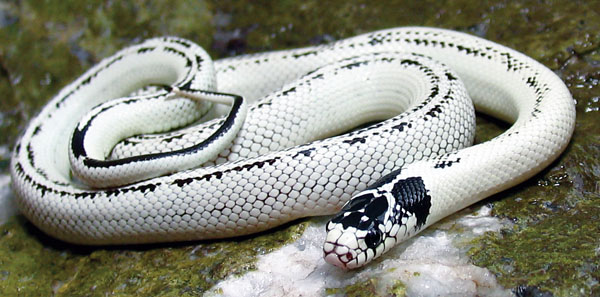
Photo by Maria Heidkamp Scully
This hatchling is a reverse double-striped high-white phase. High-whites have black on the head and neck with varying degrees of white along the body. These animals also have a dark stripe along the top of the tail.
One particularly attractive pattern phase is the 50/50 black-and-white desert phase, which possesses a zebralike appearance. Steve Osborne began this phase’s development in the 1980s. He started with a pair of highly unusual 50/50 black-and-white animals collected in the Mojave Desert. After a number of generations, these snakes were bred to equally unique specimens from Joshua Tree, Calif.; Clark County, Nev.; and San Felipe, Mexico. As a result of this selective-breeding program, the percentage of white markings along the length of the snake’s body increased significantly. This is a primary characteristic of the animals derived from this line.
These snakes often display a striking bright-white-against-black contrast in their banding patterns. The resulting black-band pattern can be more accurately described as black splotches or spots, and this pattern phase is usually described as a percentage of white to black, such as 70/30, which means 70 percent white and 30 percent black. Animals from this lineage usually have a temperament more docile than some other common California kingsnake morphs.
Some morphs or phases available are:
• black-and-white
• normal-banded
• chocolate-and-yellow
• normal-banded
• normal striped
• wide striped
• reverse striped
• reverse wide-striped
• dotted
• dot-dash phase
• scissors crossing
• high whites
• high yellows
• Aztec or mixed patterns in black and white, or brown and yellow
• albinos in many pattern types
• lavender banded
• 50/50 black-and-white banded
• 50/50 brown-and- yellow banded
Collecting Treasure
If you enjoy the excitement of herping and wish to keep your finds, be sure to first check with the fish and game department of the state where you’ll be searching. In California, for example, there are specific limits for wild collection of California kingsnakes. Their captive breeding is also regulated in the state, and a propagation permit is required for those who wish to breed and sell California kingsnake offspring.
The Royal Abode
Careful record-keeping of your snake’s activities is one of the best ways to monitor your pet’s health and to be prepared if problems should develop. Record when your snake sheds, eats and defecates. Nutritional problems usually do not arise in snakes feeding well. This is in large part because snakes consume their entire prey, bones and all. Refusal to eat, however, is often the first indicator of an underlying pathology. If you visit a veterinarian, take your snake’s most recent stool sample with you. It will help with diagnostics for the presence of parasites. Although California kingsnake care is largely straightforward, problems do occasionally arise. Being aware of your snake’s captive requirements can vastly improve your pet’s health and happiness.
A Majestic Captive
Caring for this attractive snake is not only easy but also very rewarding. With all the different colors available and their inquisitive personality, they offer keepers a royal experience all the way around. It’s understandable why they’ve become so popular.
Learn More
Bartlett, R.D., and R.G. Markel. 2005. Kingsnakes and Milksnakes: A Complete Pet Owner’s Manual. Barron’s Educational Series, Hauppauge, New York.
Mader, D.R. 2006. Reptile Medicine and Surgery. 2nd ed. W.B. Saunders Company, Philadelphia, Pennsylvania.
Rossi, J.V., and R. Rossi. 2003. Snakes of the United Sates and Canada: Natural History and Care in Captivity. Krieger Publishing Company, Malabar, Florida.


